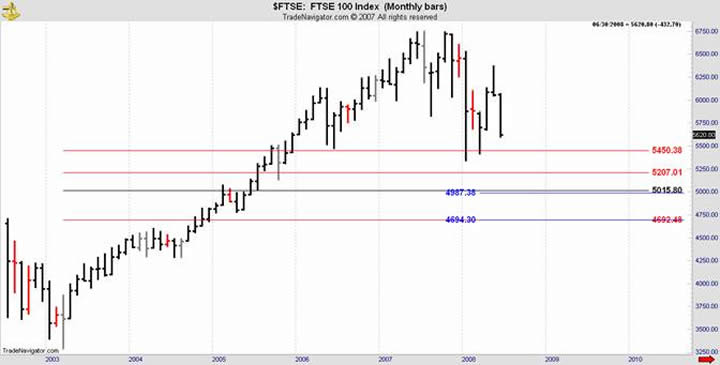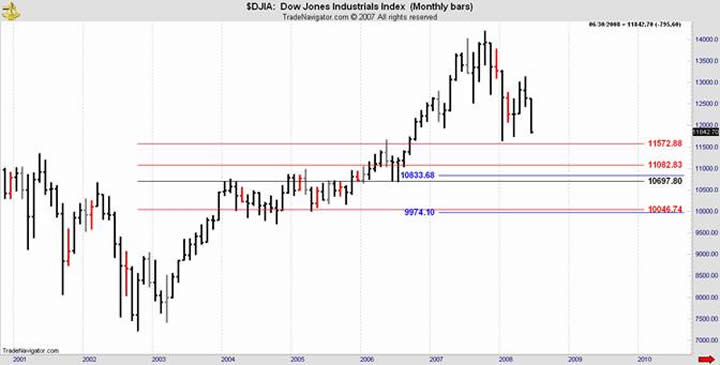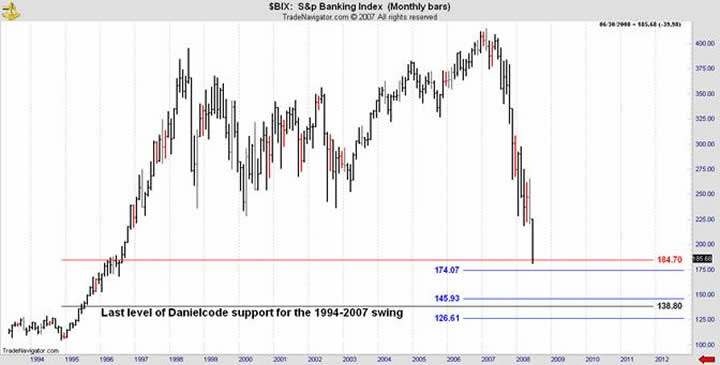FTSE 100 Index and the Atlantic Stock Market Divergence
Stock-Markets / UK Stock Market Jun 23, 2008 - 07:33 AM GMTBy: John_Needham

 Behind the Mortgage bubble - More than one columnist has commented on the apparent divergence between the City's view of the economy and the High Street's view. Whilst the City and Threadneedle Street grapple with the onset of credit impaired securities and the heretofore unconsidered realisation that leverage cuts both ways, the High Street is largely unaware of what is coming down the track. UK and European markets are tracking about a quarter behind our cross Atlantic cousins so the path is relatively clear to see although the return to earth of the UK housing market will follow a different course to that in US.
Behind the Mortgage bubble - More than one columnist has commented on the apparent divergence between the City's view of the economy and the High Street's view. Whilst the City and Threadneedle Street grapple with the onset of credit impaired securities and the heretofore unconsidered realisation that leverage cuts both ways, the High Street is largely unaware of what is coming down the track. UK and European markets are tracking about a quarter behind our cross Atlantic cousins so the path is relatively clear to see although the return to earth of the UK housing market will follow a different course to that in US.
To understand the sudden death syndrome in US subprime mortgages it is necessary to understand the forces behind their origination. US mortgages are a very different beast to those that we know. In US the mortgage market starts with Government Sponsored Enterprises (GSEs). These range from the goliath businesses Freddie Mac and Fannie Mae, multi billion dollar businesses which enjoy an implied government guarantee on their paper whilst having private stock holders and being listed on NYSE, to a variety of smaller GSEs all actively doing the government's bidding. Because of the hybrid nature of these corporations they are immune to the rigors of private enterprise. They raise money at near Treasury rates, originate mortgages and buy in complying mortgages from other originators. They wrap and parcel those loans all with an AAA rating against their implied government guarantee. Losses and failures in their product are eventually borne by taxpayers and they are the conduit for the present $300 billion mortgage bailout bill now before Congress.
The other major differences in US mortgages is that although the vary on a state by state basis, the default setting is they do not have personal guarantees from the mortgagor. Add this to the industry wide practice sanctioned by the US courts of down payment assistance and you see a different flavour in US mortgages.
This from the US Home Down payment Gift Foundation website: The best-kept secret behind the sustained strength of the residential real estate market is the creation of a new pool of buyers who can afford their mortgage payments but lack the cash for a down payment. In the past these potential buyers had little hope of owning a home. Today, thousands of these individuals are becoming homeowners. According to both HUD and Minneapolis Federal Reserve, the number one barrier to homeownership in the U.S. is the lack of down payment money. With President Bush's initiative to increase minority homeownership by 5.5 million by the year 2010, there is an increased need for organizations that can provide assistance through the use of private capital. Through the use of private capital, the non-profit down-payment industry now makes possible over 17,000 home purchases each month for low to moderate income buyers. Today these Down payment Assistance Programs (which are not just for 1st time homebuyers) are helping many people live the dream of home ownership.
Of course this self serving statement from the website of one of the biggest “Gift” foundations is just spin. They are not gifts at all. Just a round robin tacked onto the purchase price which ensured that already overpriced homes had a further 7-10% added onto their price as the purchaser's down payment becomes the vendors “donation” to the gifting entity. Add to that most US mortgage payments being current year tax deductions (yes, on private homes) and you can see the drivers for mortgage mania that is now unraveling.
The triggers for the speed and ferocity of the mortgage collapse in US is not only subprime NINJA loans (no income, no job, no asset) but the ability to walk away from a defaulting mortgage with no more pain than the loss of deposit (usually none) and some credit impairment.
FTSE and Dow
So why is the FTSE relatively weaker than the Dow?
Here is the FTSE which breached the first level of Daniel number support at 5450 in January and is now headed to 4694 if this is merely a normal market correction, which I doubt:

Here is the Dow which has yet to breach its first level of Danielcode support which is a 37.5% retracement of the bull market:

The answer is in the relative weighting of major banks in these indices. The S&P bank index below has already retraced 74% of its total price rise from 1994. So far the market is punishing banks, issuers of impaired credit bonds (because they have buy back contingencies), bond insurers and those close to the action. The market has not fully realised yet the salient factors flowing from these capital depleted banks.
Their general lending is going to be markedly constrained in the obvious areas of housing and construction, but going forward, banks that have been party to faulty asset securitisation paper have been booking notional profits on that paper for the past decade. They are not going to be able to emulate those sort of profits from traditional lending.

As such the whole edifice based on phony profits is going to be torn down before it is rebuilt. The flow through to businesses and consumers addicted to easy money and lax loan standards is going to be traumatic and a hard learned lesson.
Folks might have to start thinking of living in homes they can actually afford and driving cars that they can pay for. That will be the greatest shock of all!!
I invite you to visit the Danielcode Online where you can learn more about these amazing numbers that define all markets in all timeframes.
by John Needham, The Daniel Code Report | June 23, 2008
See http://www.thedanielcode.co.uk for the full article and for more information about DC Numbers including a free two week trial .
John Needham is a Sydney Lawyer and Financial Consultant. He publishes The Danielcode Report and writes occasionally on other markets. He lives with his family in Australia and New Zealand .
John Needham Archive |
© 2005-2022 http://www.MarketOracle.co.uk - The Market Oracle is a FREE Daily Financial Markets Analysis & Forecasting online publication.


